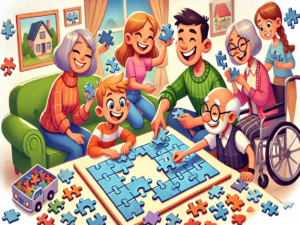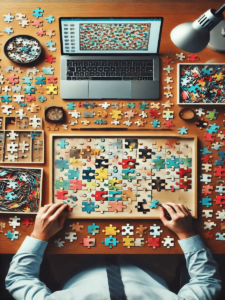Why Jigsaw Puzzle Solving Can Be Slower Than You Think
Jigsaw puzzle solving is a fun and relaxing way to spend your free time, but sometimes, we unintentionally develop habits that slow us down. Whether you’re tackling a 500-piece puzzle or a challenging 1,000-piece one, the goal is always the same: to solve it as efficiently as possible. However, many puzzlers unknowingly fall into common traps that make the process take longer than necessary.

When you’re solving a jigsaw puzzle, it’s easy to get caught up in the excitement of piecing things together quickly. But some habits – like jumping into the puzzle without sorting pieces, or focusing too much on color matching – can actually hold you back. The key to speeding up your jigsaw puzzle solving isn’t just about working faster, it’s about working smarter. By tweaking a few strategies and being mindful of your approach, you can improve your puzzle-solving speed without sacrificing fun.
Table of Contents
1. Starting Without Sorting the Pieces
One of the most common mistakes is jumping straight into the puzzle without first sorting the pieces. Many solvers dive in headfirst, wasting precious time searching for specific pieces.
How to Fix It:
Before you start assembling the puzzle, take a few minutes to sort the pieces. Organize them by color, edge pieces, and patterns. This makes finding the pieces you need much quicker.
2. Ignoring the Edge Pieces
Some solvers neglect the edge pieces, hoping they’ll fall into place naturally. The edge pieces are the frame of your puzzle and the key to starting the assembly process efficiently.
How to Fix It:
Start by identifying all the edge pieces and complete the border first. This gives you a clear starting point for the rest of the puzzle and helps define the layout.
3. Focusing Too Much on One Section
It’s tempting to focus all your attention on one area when jigsaw puzzle solving, especially when you’re close to completing a section. However, this can slow you down by isolating sections that could otherwise connect.
How to Fix It:
Step back and look at the puzzle as a whole. Be sure to move between sections, as this will help you find connections and avoid getting stuck.
4. Trying to Force Pieces Into the Wrong Spots
One of the most frustrating habits is trying to force pieces into positions where they don’t fit. This not only wastes time but can also give you the wrong impression about the puzzle’s structure.
How to Fix It:
Instead of forcing pieces, take a moment to step back and reevaluate. Look for other possible connections and focus on fitting pieces that naturally align.

5. Neglecting to Check for Puzzle Piece Numbers
Many jigsaw puzzles solving techniques include the puzzles have numbers on the back of the pieces to indicate their position. Ignoring these numbers can lead to unnecessary guesswork.
How to Fix It:
Check the numbers on the back of the pieces if your puzzle has them. This can give you a hint about where to start or help you place pieces more quickly.
6. Overcomplicating Color Matching
Color matching is crucial, but overthinking subtle shades can slow down your process. Spending too much time searching for just the right shade can leave you frustrated and stuck.
How to Fix It:
Don’t get bogged down by tiny differences in color. Look for larger, more obvious color groupings that fit together, and trust your instincts when matching similar shades.
7. Focusing on Completing the Image Instead of the Shape
It’s easy to get fixated on completing the image, but sometimes the shape of the pieces is more important. Relying too much on the picture can cause you to miss the crucial shape connections.
How to Fix It:
Pay more attention to the shape of the pieces and their interlocking patterns. Completing sections based on the shape can often be faster than working solely from the image.
8. Not Taking Breaks When Stuck
Staring at the same section of the puzzle for too long when you’re stuck can actually make you slower. Fatigue and frustration set in, making it harder to spot connections.
How to Fix It:
If you’re feeling stuck, take a short break. A few minutes away from the puzzle will refresh your mind and give you a new perspective when you return.
9. Not Keeping the Puzzle Area Organized
A cluttered puzzle area can be a big time-waster. When pieces are scattered all over, it’s hard to find the ones you need, and it can take longer to piece them together.
How to Fix It:
Keep your puzzle area tidy and organized. Use trays or containers to separate groups of pieces. A clean workspace makes it easier to locate the pieces you need and keep the puzzle progressing smoothly.
Speed Puzzling: Your Journey to a Faster Solution
Incorporating speed puzzling into your routine doesn’t have to mean rushing through your jigsaw puzzle solving techniques. It’s all about being more strategic in how you approach the pieces and making smarter decisions along the way. By breaking bad habits like ignoring edge pieces or forcing pieces into place, you can start solving puzzles faster without compromising the enjoyment. These small adjustments can make a big difference, turning a slow puzzle-solving process into a smoother, more efficient experience.
Next time you sit down to solve a jigsaw puzzle, keep these tips in mind and practice them. With a little time and effort, you’ll find that your jigsaw puzzle solving speed improves naturally. So, whether you’re tackling a casual puzzle or taking on a more challenging one, try implementing these strategies to see just how much faster and more enjoyable your speed puzzling sessions can become!
